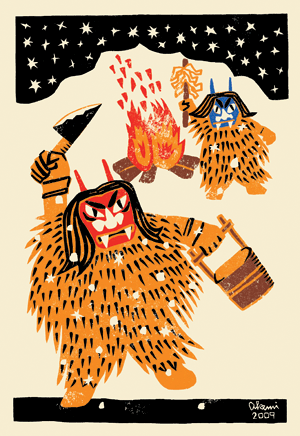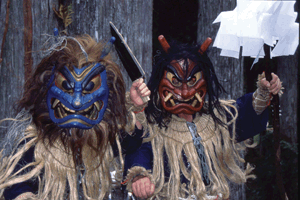Snow DevilsAkita: Oga Namahage Years ago Japanese festivals took place in front of the gods; now they take place in front of cameras. The villagers of the Oga Peninsula have given much thought to this development and have arrived at the perfect solution. If you look at a festival calendar you will see that the Oga Namahage Festival takes place on the 13th, l4th and l5th of February. Those are the dates under which it is listed as one of the ‘Five Snow Festivals of Tohoku’. On those nights the famous masked, straw-clad demons appear in the grounds of the shrine on Mount Shin and perform a few brief dances. They are actually members of tourist organizations, but the cameramen are not to know this, and the masks look just as good and just as fierce whoever is behind them. Most of the photographs of the Namahage are taken during those three nights and most of the tourists who are present go home content in the belief that they have witnessed an important traditional event. 
Illustration by Shinohara Akemi In fact, the cameramen and the tourists have missed the event by about six weeks. The real Oga Namahage Festival takes place not in February, but on New Year’s Eve; not in a shrine, but in the homes of the villagers, and the people behind the demon masks do not belong to tourist organizations but, as tradition demands, to the young men’s associations of the villages. They have a history of perhaps a thousand years behind them and the annual event they stage is among the last and most genuine of the folk festivals of Japan. No wonder they keep the tourists away. Late December, and the little hot spring resort of Yumoto is shuttered and deserted. Dusk falls at noon and, throughout the day, a thin half-hearted sleet. In the gloom of the kominkan – the little wooden shed that serves the village as a community centre – an old man sits plaiting a straw cape and staring out of the window at the dark sky. “He was a Namahage in his time,” whispers Mori. “I remember him when I was a child. I always knew who was behind the mask, but it made not the slightest difference; he could put the fear of the devil into you. Every year I told myself I wouldn’t cry, and every year I cried.” The name of these snow devils comes from the dialect word namomi, meaning a rash of red spots, and the verb hageru, meaning to ‘peel off’ or ‘take away’. The purpose of the Namahage’s visit is to threaten and punish lazy people – people so lazy, for example, that they sit all day with their legs in the warm kotatsu, which is how they get the spots. The main targets are newcomers to the community – children who have yet to learn their place, and young women who have recently married into the village and must be taught the virtue of hard work. “When I was young,” says Mori, “there was no place you could escape them. They’d pull you out of the bath if they found you there. We lived by the beach and I was so terrified that I used to go out and hide behind the sea wall in the deep snow; but it did no good; they always caught me.” One surprise is the words used for counting Namahage and other demons – ippiki, nihiki – the same words used for counting animals. In this village of sixty houses there will be four Namahage – yonhiki – and these will split into two teams which, between them, will visit all of the houses, except for the three in which a death has occurred during the past year. Despite their threats of violence and their demands for gifts of sake and money, the Namahage are regarded as bringing good luck to the houses they visit. The bits of straw that fall from their capes in the course of all the stamping and pushing are not swept up till the following morning, and some of the bits are kept in drawers as charms against illness and pain. “There’s another man – he’s still quite young, though he doesn’t take the part of a Namahage any more. He’s so tall -tall as a foreigner – that he only had to appear in your doorway in a mask and your whole body went cold. When Japan started trying to be a ‘modern’ country back in the middle of the nineteenth century, the government wanted to ban the Namahage. It was primitive, they said – and perhaps it is. It was cruel, they said – well, yes, and so are men. We get sightseers here – it can’t be helped – we’ll get some tomorrow. The head of the village and the priest of the shrine have both invited a couple of busloads. But they’ll see nothing. There are no children in those houses, and the Namahage’ll go there first, before they’ve drunk, before their blood’s up. You wait. Let them call it what they like. You wait. You wait and see.” December 31st. Dark at five. In the kominkan the long straw capes are carefully wrapped and tied round the demons’ bodies. Each wears three, and with their thick straw boots and with the wild, huge red and blue masks on their faces, they are twice the size of ordinary men. Even under the yellow electric lights, with people from the youth hostel looking on, they strike an awesome silence in whoever sees them. Each carries a stick to bang on the floor and a wooden silver-painted knife (one is stuck together with cellotape where a drunk demon cracked it the year before). They prowl about the tiny hut like caged bears until the signal comes to start. The priest blesses them, the young men toast them. At six o’clock the night swallows them. At the house of the village head, with its two buses parked outside, the Namahage are well-behaved. They stamp and roar in the right places and go through the motions of looking for children, knowing they will find none. They drink the sake they are offered tamely and leave five minutes after they arrived. At the house of the priest they do the same and the happy tourists applaud them. For a little while we stand waiting in the darkness of a narrow alley, out of the gleam of the headlights. The tourists climb back into their buses. We hear the engines start, we watch them leave. By seven o’clock the black streets are empty. The festival begins. Cruel? I don’t know. To those of us whose only childhood visitor was Santa Claus, the Namahage stand the world on its head. They do not bring presents, they demand them. They do not reward good children, they threaten good and bad alike. Two little brothers, one nine, one seven, sit with their parents around the hearth. Their grandmother nurses a wide-eyed baby, singing to it softly, telling it that it will come to no harm. The Namahage enter, stamping and roaring, drunker at every house they visit. The nine-year-old giggles. The seven-year- old bites his thumb. “Waaaaww! Waaaaww!” the Namahage roar, thumping round the room in their mud-covered straw boots. “Any lazy little devils here? Any nasty, lazy little brats?” The nine-year-old stops giggling. The Namahage grab him by the waist and begin stuffing him head first into the sack they have brought for gifts. “You’re coming to the mountain, you are, little brat! We’ll teach you! We’ll show you! Waaaaww! Waaaaww!” The baby and the seven-year-old brother scream together. The nine-year-old, half in, half out of the sack, gives up the attempt to hold back his tears. His cheeks look as though they have broken out in a rash. He knows who the Namahage are; he has seen and spoken to these young men every day for as long as he can remember, and he is beside himself with terror. Another house. A little five-year-old girl who has been sitting quietly watching the cartoons on television has hidden herself behind the living-room sofa. The Namahage stamp through the house and fail to find her. The mother smiles and winks at the sofa. They drag the little girl from behind it, screaming, white-faced, with hardly enough breath in her body to shout “Mummy! They carry her into the next room, where the trays of sake are laid out for them, and then – to top all previous terror – the little girl herself, sobbing pitifully, is made to pour their sake for them. “They used to go on till midnight,” says Mori, as we stand in the cold, empty air of the street, listening to the banging and roaring from inside the house, watching the giant shadows stride across the paper screens. Dogs bark. Children scream. New Year on the Oga Peninsula. “They’ll finish at nine tonight, I expect. They’ll want to go back and watch Kohaku.” “Are they always this violent?” “Violent? Huh! They’re as timid as mice if you ask me. It’s not like the old days when practically everyone ended up with a broken window. Why, I remember… “ And he stops and laughs and fills my sake cup, and then says nothing for a long time. “Do you see…” he continues slowly, “why? Do you see how it binds the village together? Teaches everyone their place? Teaches them what’s wanted of them? Does it with humour, without real harm? Those children will be Namahage themselves in a few years’ time. Do you see how…good…it is?” I sip my sake and listen to the dogs barking. “Yes, I do,” I say. My breath is white in the last air of December. “Is it cruel?” “It’s good,” I say. “It’s very, very good.” “Is it primitive?” “Yes,” I say. “It’s fine.” |
雪の鬼秋田男鹿のなまはげ 数年前まで日本の祭りは神々の御前で行われていた。今その祭りはたくさんのカメラの前で行われている。男鹿半島の村人達はこの変わり様をどうしたものか考えあぐね、完璧な解決策にたどりつく。 祭り暦をみると、男鹿のなまはげ祭りは2月の13日、14日、15日に開催され、「東北の5大雪祭り」の期間にあたる。この三晩に真山のふもとにある神社にあの有名なお面をつけ藁蓑をまとった鬼が姿を現し、なまはげ踊りを披露する。なまはげを演じるのは観光協会の人たちだが、そんなことは写真を撮るカメラマンたちは知る由もない。それに誰がつけようと面は立派だし恐ろしい。なまはげの写真はほとんどこの3日間に撮られたもので、そこにいた観光客は貴重な伝統行事をみることができたと信じ満足して帰っていく。 でも実は、カメラマンも観光客も大事な行事を6週間ほど前に見逃している。本物の男鹿なまはげ祭りは、2月にではなく大晦日に行われる。神社ではなく村民の家で、観光協会の人ではなく村の青年団がならわしで鬼の面をかぶる。おそらく何百年もの歴史ある祭りで、日本で最後のそして正真正銘の民俗伝承祭りだ。観光客を遠ざけたくなる気持ちもよく分かる。 昨年12月、ひっそりとたたずむ湯本温泉郷は閉鎖され人けもない。お昼にはほこりが舞い、一日中ぱらぱらとみぞれが降っている。公民館 ―村の集会所として建てられた木造小屋―の暗がりに一人おじいさんが座り、窓の外に広がる暗鬱な空を眺め藁で袈裟を編んでいる。 「あのおじいさんは昔なまはげだったんだよ。」と森さんがささやく。 この雪の鬼の名前の由来は、この地方の方言なもみに由来し、赤い発疹を意味する。その動詞であるはげるは「はがす」または「取り除く」の意味がある。このなまはげが家を訪れるのは怠け者を脅かし懲らしめるためだ。怠け者というのは、例えば一日中ぬくぬくとこたつに入って過ごし足に発疹ができる人のことを指す。標的になるのは、村の新参者で、つまりこれからたくさん学ぶことのある子供たち、そして身を粉にして働かなければならない村にきたばかりの若嫁たちだ。 「ぼくが小さかった頃は」と森さんは続けた。「どこにも逃げ場がなかった。お風呂場に隠れていても、見つかったら引っ張りだされる。海岸沿いに住んでいたから、あまりの怖さによく外にでて雪が深く降り積もった防波堤の陰に隠れていたよ。でもそれも無駄な抵抗でいつも見つかっていた。」 驚くことに人々は、なまはげや他の鬼を数えるときにイッピキ、ニヒキと数える。これは動物の数え方と同じだ。この村には60世帯の家があり、なまはげがヨンヒキおり、二手に分かれて村中の家を回る。ただしその年に不幸があった家、今年の3軒は回らない。どれほど暴れて脅かし、酒や金銭を要求しても、なまはげは訪れる家に福をもたらすとされている。なまはげが足を踏み鳴らし押し入ってきたとき袈裟からこぼれおちた藁は、翌朝までそのままにしておき、数本を無病息災のお守りとして大切に引き出しにしまっておく。 「なまはげの他にも、面をかぶっている人がいる。まだかなり若くなまはげの儀式には参加しない。その人は外国人のように背が高く、面をかぶりただ玄関のところに現れる。それを見るだけで背筋がぞっとするものだ。19世紀半ば、日本が「近代国家」を目指し始めた頃、政府はなまはげを禁止しようとした。原始的だという理由で。そうかもしれない。それに野蛮だと。まあその通りだろう、でも人間も同じくらい野蛮だ。そして観光客が見にやってくるようになった。それは仕方がない。明日もやってくるだろう。村長と神主がバス観光客を誘致しているからね。しかし来ても何も見るものはない。子どもはいないし、なまはげは酔いが回り血が沸き立つ前にやってくる。観光客はただ待つだけ。それを何の儀式と呼ぼうがどうでもいい。ただ漠然と見るだけだ。」 12月31日。5時にはもう辺りは暗くなっている。公民館では、長い藁の袈裟が丁寧に鬼の体に巻きつけられていた。鬼はそれぞれ袈裟を3つ体に巻いて分厚い藁靴をはき、猛々しく巨大な赤と青の面を顔につけている。その面の大きさは成人男性の2倍にもなり、蛍光灯の明かりの下でユースホステルからの気軽な旅行者でさえも、彼らを見下ろす面に圧倒され畏れ沈黙する。鬼は床を叩く棒を手にし、木でできた銀色の出刃包丁をもち(一つは前の年に酔っぱらった鬼が割ってしまい、セロテープでくっつけられていた。)合図があるまで、檻にいれられたクマのように狭い小屋の中をうろついている。神主がお祓いをし、若者たちが祝杯をあげる。そして6時には夜のとばりが彼らを覆う。 村長の家では、バスが2台とまり、なまはげが行儀よく振舞っていた。定位置で足を踏みならし大声をあげ、子供がいないのを知りながら探すそぶりをする。丁寧につがれた酒を飲むと、登場してわずか5分の後に去っていった。神主の家でもなまはげは同じことを繰り返し、観光客は満足げに拍手を送っている。その間、僕たちは照明の当たらない暗く狭い通路に立っていた。観光客はバスに戻るとエンジンのかかる音が聞こえ、瞬く間に去って行った。7時には真っ暗な道路には人気もなくなり、本当の祭りが始まる。 野蛮かって?僕には分らない。子どもの頃にやってきた来客といえばサンタクロースだった僕たちにとって、なまはげは天地がひっくり返るようなものだ。プレゼントを持ってくるどころか、逆によこせと要求する。良い子だからとご褒美をくれるでもなく、良い子も悪い子もかまわずに脅す。 9歳と7歳の兄弟二人が両親と一緒に囲炉裏端に座っている。おばあさんは大きく目を開いた赤ん坊に子守り歌を歌いながらあやし、怖がることはないと話しかけている。そこになまはげが足を踏みならし大声をあげやってきた。なまはげは、訪問するごとに酒をふるまわれてどんどん酔っ払っている。9歳の子はひっくひっくと泣き出し、7歳の子は親指を噛んでいる。「ウォー、ウォー!」となまはげは大声で叫び、泥だらけになった藁靴で部屋中をどしどしと歩きまわる。「泣く子はいねぇかー?言うこと聞かねガキはいねぇかー」9歳の男の子のすすり泣きがピタッととまった。なまはげはその子を抱え上げ、もってきた袋の中に頭からすっぽりといれてしまった。「山へ連れてくぞ、この子鬼め!お仕置きするぞ。懲らしめてやるぞ。ウォー、ウォー!」赤ん坊と7歳の弟は一緒になって泣き叫んでいる。9歳の子は体の半分が袋の中に入ったままで、涙をこらえきれなくなったようだ。そのほっぺたはまるで発疹ができたかのように真っ赤になっている。この子は誰がなまはげの面をかぶっているか知っているし、毎日のように彼らを近所で見かけているはずだ。ただこの状況でそれを思い出せたらの話だが、恐怖のあまりそれどころではないようだ。 別の家。それまで静かに座ってテレビアニメを見ていた5歳の小さな女の子が居間のソファの陰に隠れる。なまはげがどかどかと家に入ってくるものの女の子を見つけることができないでいる。その家の母親が微笑みソファの方に目配せをすると、なまはげは女の子をソファの陰から引っ張りだした。叫び声をあげ真っ青な顔になった女の子は、必死にお母さん!と叫ぼうにも息をするのもやっとなほどだ。女の子はお酒の準備がされている隣の部屋に連れて行かれ、哀れなほどくしゃくしゃに泣きながらなまはげにお酌をする。 「昔は深夜まで続いたものだよ。」森さんは言う。僕たちは、寒く人気のない道に立ち、家の中から聞こえてくるドスンドスンという音やうなり声と障子越しにうつる巨大な影をみていた。犬が吠え、子供は泣き叫ぶ。そして男鹿半島の年が明ける。 「9時には終わるだろう。家に帰って紅白を見ないといけないからね。」 「なまはげはいつもこんなに暴れるのですか?」 「暴れる?ふん、今はねずみのようにおとなしいもんだ。昔はこんなもんじゃなかった。みんな窓が割れるまでやったもんだ。思い出すのは…」 と森さんは話をやめ、笑って僕のぐい呑みに酒を注ぎ、しばらく黙りこんでいる。 「わかるかい…なぜ?」とゆっくりと話だした。 「どうしたら村が一つにまとまるか分かるかい?どうやって自分たちの住む村のことや必要なルールを教えられるか?しかもユーモアを交えながら、危害を加えずに。この子どもたちは数年後にはなまはげになるんだ。わかるかいこれがどんなにいいことか?」 僕は酒をすすり、犬の鳴き声に耳を傾けた。 「ええ。」12月最後の夜に吐いた僕の息は白かった。 「野蛮かい?」 「いいと思う。」と僕は言った。「とても、とてもいいと思う。」 「原始的かい?」 「ええ」と僕は答えた。「でもそれでいいと思う。」
|









